What are Cracked Heels?
Cracked heels, a condition that is also referred to as heel fissures, are a common foot problem characterized by the development of dry, thick, and cracked skin on the underside of the heels. This condition can range from just a minor aesthetic concern to a painful and potentially infected issue, depending on its severity.
The skin on the heels is naturally subjected to increased pressure and friction, making it prone to dryness and thickening. When this protective layer becomes excessively dry and rigid, it loses its elasticity and is more susceptible to cracking. This causes painful deep cracked heels, which can be especially painful when walking or standing.
Deep cracks in the heel can bleed if not addressed on time. Bleeding heel cracks increase the risk of infection. Therefore, addressing cracked heels promptly is essential to prevent discomfort and complications.
What Causes Cracked Heels?
Why are my heels cracking all of a sudden? Several potential factors may contribute to cracked heels. The following are some of the reasons for cracked heels:
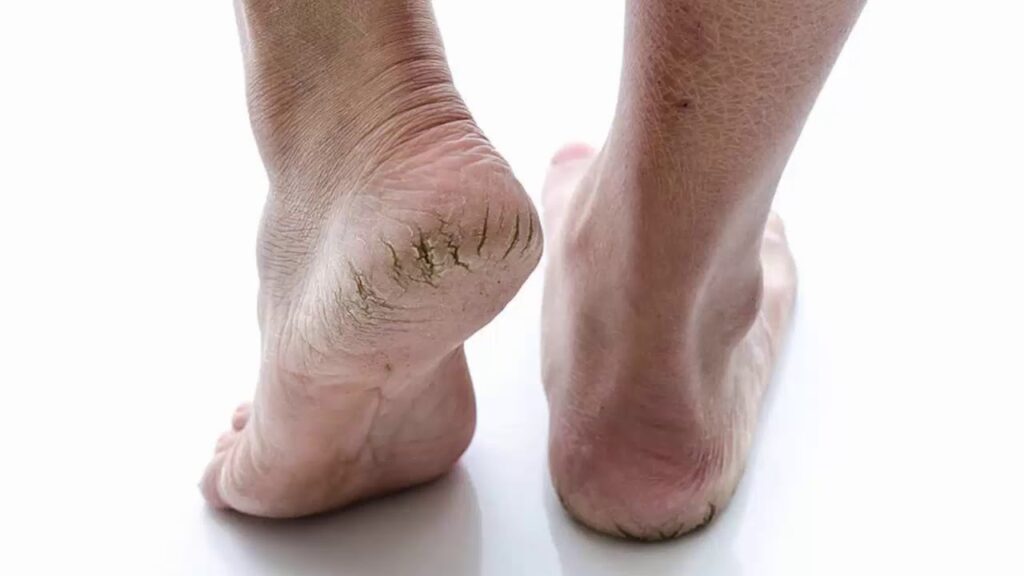
Dry skin
This is the primary culprit behind cracked heels. Our skin acts as a natural barrier, retaining moisture and protecting the underlying tissues. However, the skin on our heels lacks oil-producing glands, making it particularly susceptible to dryness. This, combined with constant exposure to air, friction from footwear, and hot water, can lead to rapid moisture loss. As the skin becomes dehydrated, it begins to thicken and harden in an attempt to protect itself. This thick and dry skin is more prone to cracking under pressure.
Excessive pressure
A lot of increased exertion on the heels can significantly contribute to the development of cracks. Activities involving prolonged standing, such as those in healthcare, hospitality, or retail, can place substantial weight on the heels. Additionally, individuals with occupations that require extensive walking or running are at increased risk. The constant impact and friction on the heel’s skin can lead to thickening, hardening, and ultimately, cracking. Overweight or obese individuals may also experience heightened pressure on their heels, exacerbating the issue, and eventually leading to deep painful cracks in heels.
Obesity
Extra weight can significantly exacerbate the risk of developing cracked heels. Excess body weight places increased pressure on the feet, particularly on the heels. This added stress causes the fat pad beneath the heel to spread out laterally, putting a large level of strain on the surrounding skin. As a result, the skin becomes more prone to thickening, drying, and ultimately cracking. Obesity can also contribute to other factors that increase the likelihood of cracked heels, such as decreased mobility since it’s painful from cracked heels, and difficulty with proper foot care.
Age
The aging process brings about several changes to the skin, one of which is decreased moisture production. As we get older, our skin’s natural oil producing glands become less active, resulting in drier skin. This reduction in hydration can affect the entire body, but it is particularly noticeable in exposed areas such as the heels. Dry, dehydrated skin is less flexible and more prone to cracking, making older individuals more susceptible to heel fissures. Additionally, the natural aging process can lead to skin thinning, reducing its protective barrier function and increasing vulnerability to external stressors. And eventually, dry cracked feet cause immense discomfort.
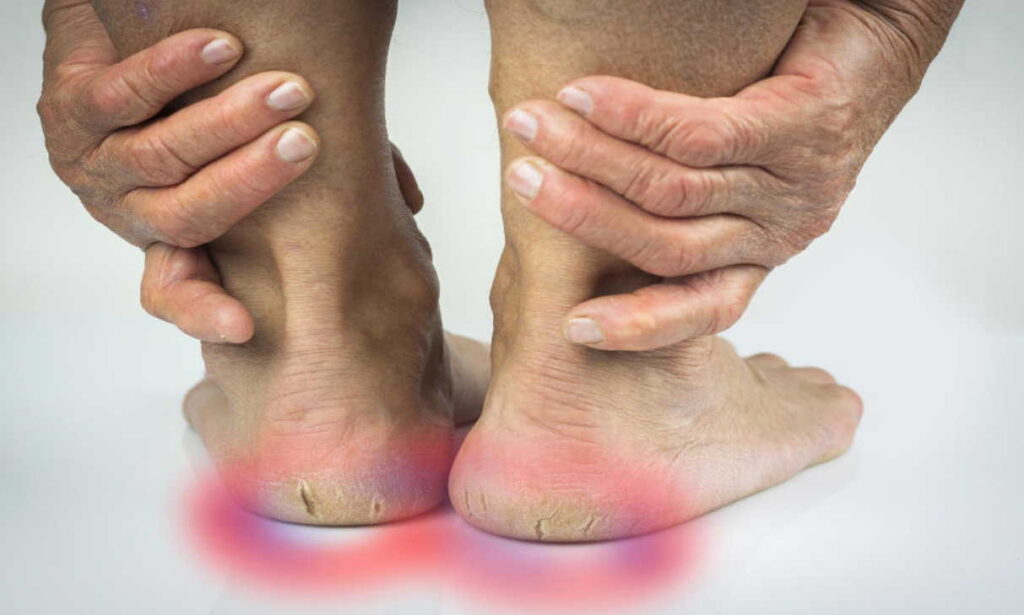
Certain medical conditions
Cracked heels are associated with certain medical conditions and can be the reason for dry heels.
Diabetes can disrupt the body’s ability to regulate blood sugar levels, leading to nerve damage and reduced blood flow. This impaired circulation can negatively impact your skin health, causing dryness, thickening, and cracking. Additionally, high blood sugar levels can weaken the body’s immune response, making individuals with diabetes much more prone to infections that may complicate cracked heels.
Eczema, a known chronic skin condition characterized by inflammation and dryness, can severely affect the heels. The skin barrier is compromised in eczema, leading to excessive moisture loss. This dry, irritated skin is more prone to cracking, causing severe cracked heels, and can be difficult to heal due to the ongoing inflammation.
Thyroid disorders, both hyperthyroidism (overactive thyroid) and hypothyroidism (underactive thyroid) can impact skin health. Thyroid hormones play a crucial role in regulating metabolism and skin cell turnover. Imbalances in thyroid function can lead to dry, scaly skin, including on the heels, increasing the likelihood of cracking.
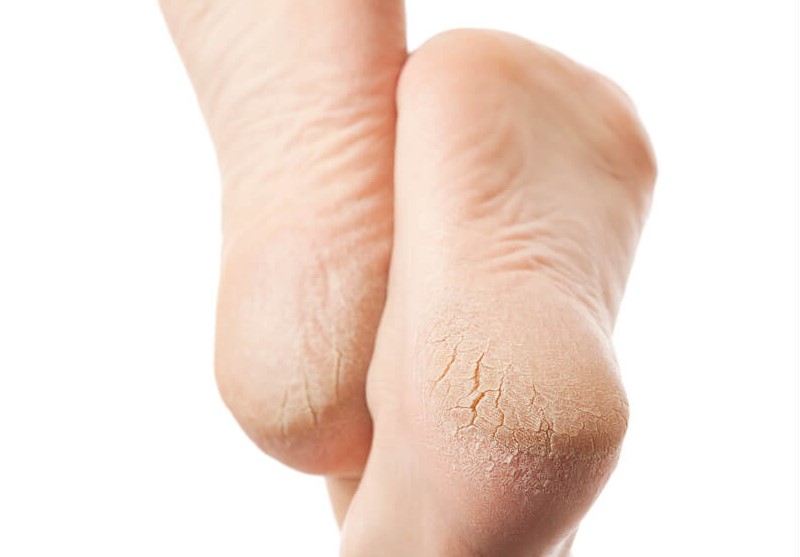
Cracked Heels During Pregnancy
Pregnancy can bring about a host of physical changes, and unfortunately, cracked heels are a common complaint among expectant mothers, since a foot crack causes added stress. Several factors contribute to this uncomfortable condition:
- Hormonal changes: The hormonal fluctuations experienced during pregnancy can lead to skin dryness, reducing its elasticity and increasing the likelihood of cracking.
- Weight gain: The extra weight carried during pregnancy puts additional pressure on the feet, particularly the heels, contributing to dryness and cracking.
- Fluid retention: Many pregnant women experience swelling in the feet and ankles due to increased fluid retention. This can further increase the level of dry skin and lead to cracked heels.
- Posture changes: As the pregnancy progresses, changes in posture and weight distribution can put extra strain on the feet, contributing to the development of cracked heels.
It’s important to address cracked heels during pregnancy, as they can cause discomfort and even become painful. Proper foot care, including moisturizing, exfoliation, and wearing supportive footwear, can help alleviate the symptoms and prevent further complications.
Who is Prone to Cracked Heels?
People who are more likely to experience cracked heels include:
- Those who spend long hours standing or walking.
- People who are overweight or obese.
- Individuals with dry skin conditions like eczema.
- Older adults.
- People with diabetes.
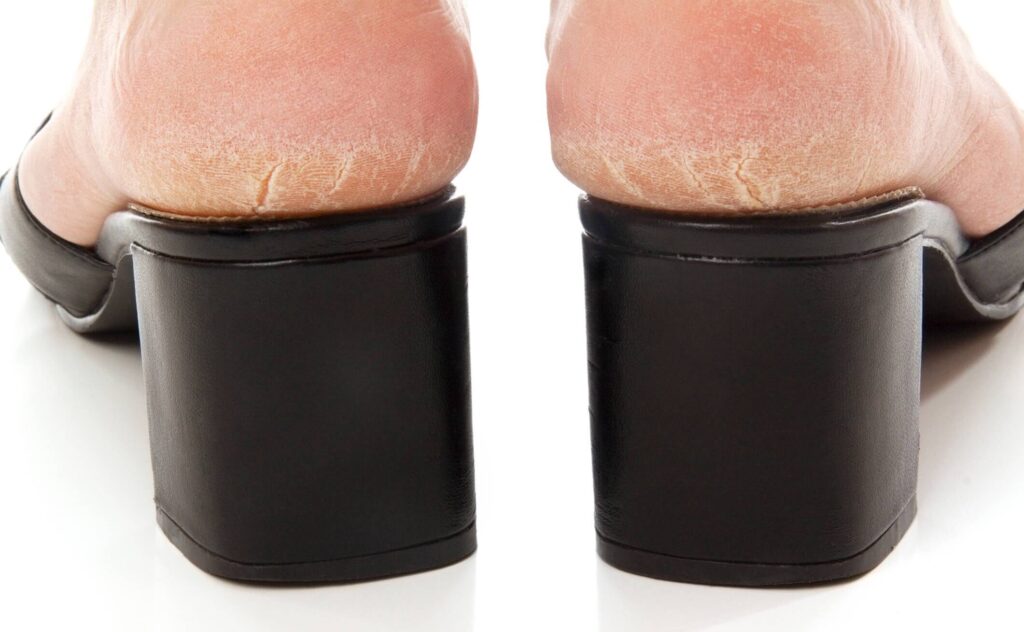
Risk Factors for Cracked Heels
In addition to the causes mentioned above, certain other factors can increase your risk of developing cracked heels, such as:
- Living in a dry climate.
- Frequently wearing open-back shoes or sandals.
- Neglecting foot care.
How to Treat Cracked Heels at Home
With consistent care, cracked heels can often be effectively managed at home with a simple approach, since we all know a crack in the heel hurts. Here’s a step-by-step guide to a DIY pedicure that can help:
Gather Your Supplies:
- Epsom salt
- Thick moisturizer (containing shea butter, cocoa butter, or hyaluronic acid)
- A pumice stone or foot file
- Large basin or tub
- Towel
- Heel protectors or socks (optional)
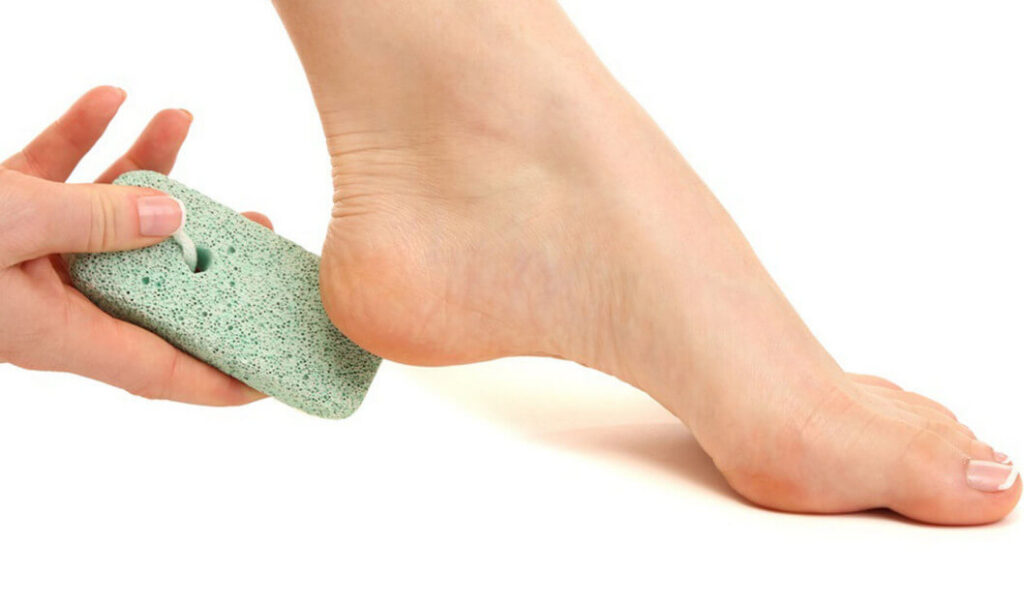
The DIY Pedicure:
- Soak Your Feet: Fill a large basin or tub with warm water and add a generous amount of Epsom salt and a tablespoon of olive oil for further added benefit. Soak your feet for about 20 minutes to soften the hardened skin.
- Exfoliate: Gently remove dead skin from any deep crack in the heel using a pumice stone or foot file while your feet are damp after bathing. Avoid excessive scrubbing, as this can irritate the skin and may even worsen cracks.
- Dry Thoroughly: Pat your feet dry with a clean towel, paying special attention to the areas between your toes.
- Deep Moisturize: Apply a thick, emollient cream or lotion to your feet, especially your heels. Look for products containing ingredients like shea butter, cocoa butter, or hyaluronic acid. For extra hydration, consider using petroleum jelly or lanolin as a barrier to lock in moisture. These can soften hard heels.
- Lock in Moisture: For maximum hydration, you can wear cotton socks or heel protectors overnight.
- Repeat this process 2-3 times a week for best results.
Additional Tips:
- Choose a moisturizer specifically designed for dry, cracked skin.
- If you have sensitive skin, opt for a pumice stone over a metal foot file.
- Avoid excessive exposure to water, as it can dry out your skin.
- Drink plenty of water to stay hydrated from within.
Product Selection for Cracked Heels
Utilize creams or ointments containing urea or alpha-hydroxy acids to help exfoliate and moisturize the skin. Consider using heel protectors or socks to cushion your heels to prevent further irritation and reduce the chance of developing any painful cracked heels.
Lifestyle Changes
Wear closed shoes, especially in dry climates, to protect your heels from harsh conditions. Avoid unnecessary prolonged standing or walking without proper footwear. Maintain a healthy weight to reduce pressure on your feet. Drink plenty of water to stay hydrated from within.
When to See a Podiatrist, Best Pedicure for Cracked Heels
While home remedies can help, it’s essential to consult a podiatrist if:
- Your cracks are deep or painful.
- You have diabetes or any other medical condition that affects your feet.
- You have signs of infection, such as redness, swelling, or pus.
- Home treatments aren’t improving the condition.
A professional or medicated pedicure can greatly help with cracked heels, but it’s crucial to choose a reputable salon with clean equipment to prevent the possibility of infections. For severe cases of cracked heels, a paraffin wax pedicure performed by a podiatrist is often the best option. This would even be considered the best treatment for dry cracked heels.
A paraffin wax pedicure is a heel cracks treatment that involves dipping the feet in warm, melted paraffin wax several times to create a moisturizing layer. The heat from the wax helps to soften the skin, improve circulation, and relieve pain. This treatment is particularly beneficial for dry skin on heels of feet and cracked heels.
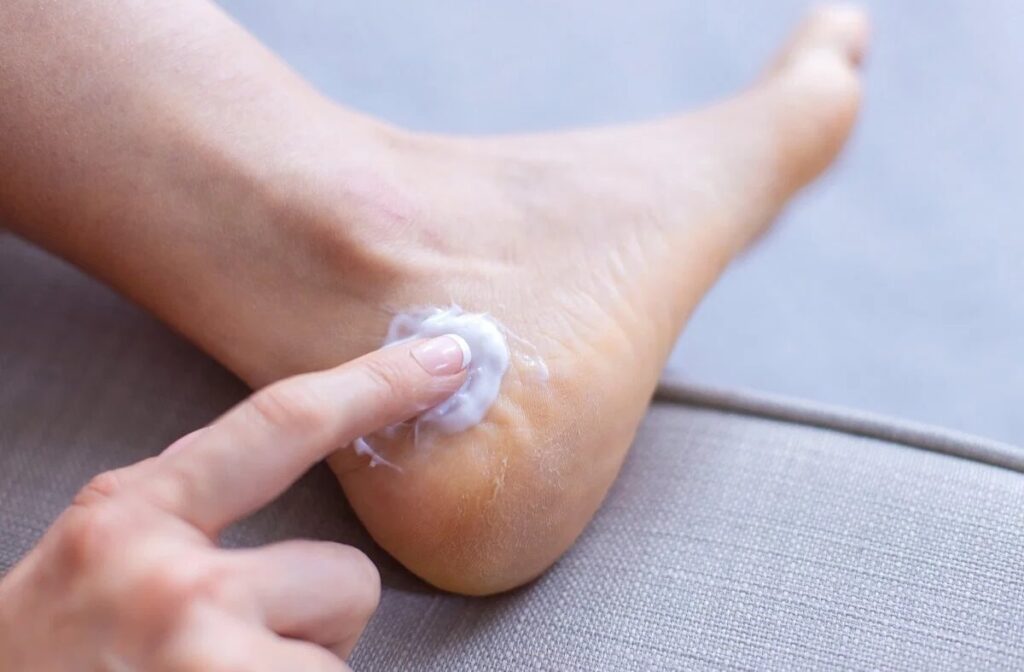
How to Prevent Heel Cracks
To keep your heels soft and smooth, and prevent those pesky cracks from returning, follow these tips:
- Moisturize religiously: Apply a thick, hydrating cream or lotion to your feet, especially your heels, multiple times a day. Look for products containing ingredients like shea butter, cocoa butter, or hyaluronic acid.
- Protect your feet: Wear closed-toe shoes, especially in dry climates, to shield your heels from harsh conditions.
- Limit water exposure: While soaking your feet can be soothing, however, prolonged exposure to water can dry out your skin.
- Maintain a healthy weight: Excess weight puts extra pressure on your feet, contributing to cracked heels.
- Choose the right socks: Opt for moisture-wicking socks to help keep your feet dry reduce friction and decrease the chance of deep cracks in heels.
- Regular foot care: Gently exfoliate your heels with a pumice stone or foot file to remove dead skin and help rough skin on heels, but be gentle to avoid irritation.
- Consider heel protectors: Using heel cushions or socks can help protect your heels from further damage.
Incorporating these habits into your daily routine can significantly reduce the risk of cracked heels and enjoy softer and much healthier feet.
The Bottom Line
Cracked heels can be a bothersome and even painful condition, but with proper care and attention, they can be effectively managed and successfully prevented. By understanding the possible reasons, and causes of heel cracks, such as dry skin, excessive pressure, and underlying health conditions, you can take steps to protect your feet. Regular moisturizing, gentle exfoliation, and choosing the right footwear are essential for maintaining healthy heels. Consulting a podiatrist can provide expert guidance and treatment options if you struggle with persistent or severe cracked heels. Remember, healthy feet are important for overall well-being, and knowing how to fix cracked heels permanently is an important part of it, so prioritize foot care as a part of your daily routine.

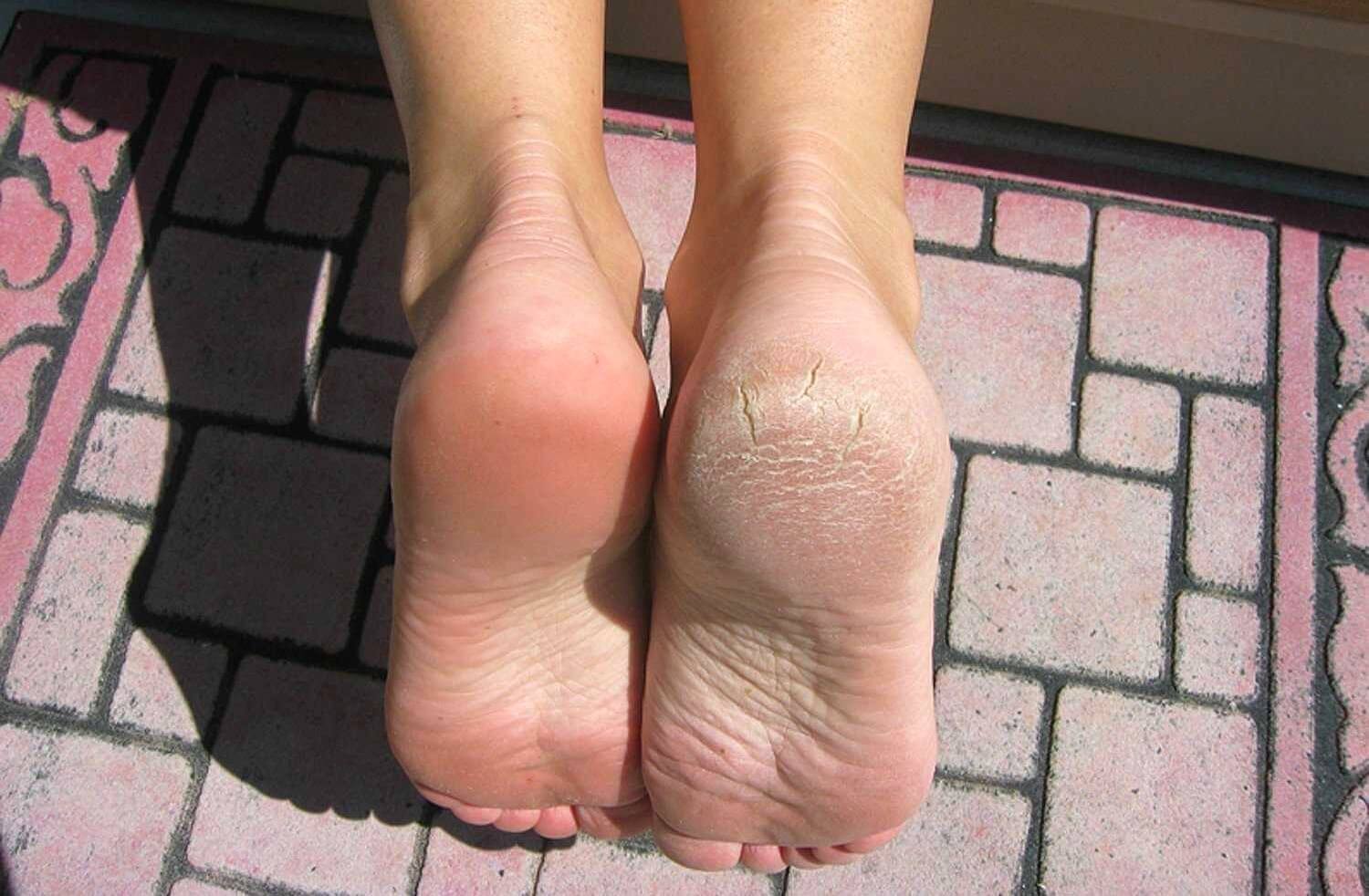
Very helpful article
Your comment made my day! Thanks for reading and sharing your thoughts❣️